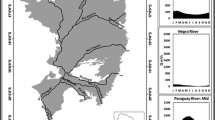Abstract
Limnologists had an early preoccupation with lake classification. It gave a necessary structure to the many chemical and biological observations that were beginning to form the basis of one of the earliest truly environmental sciences. August Thienemann was the doyen of such classifiers and his concept with Einar Naumann of oligotrophic and eutrophic lakes remains central to the world-view that limnologists still have.
Classification fell into disrepute, however, as it became clear that there would always be lakes that deviated from the prescriptions that the classifiers made for them. Continua became the de rigeur concept and lakes were seen as varying along many chemical, biological and geographic axes. Modern limnologists are comfortable with this concept. That all lakes are different guarantees an indefinite future for limnological research.
For those who manage lakes and the landscapes in which they are set, however, it is not very useful. There may be as many as 300 000 standing water bodies in England and Wales alone and maybe as many again in Scotland. More than 80 000 are sizable (>1 ha). Some classification scheme to cope with these numbers is needed and, as human impacts on them increase, a system of assessing and monitoring change must be built into such a scheme. Although ways of classifying and monitoring running waters are well developed in the UK, the same is not true of standing waters. Sufficient understanding of what determines the nature and functioning of lakes exists to create a system which has intellectual credibility as well as practical usefulness. This paper outlines the thinking behind a system which will be workable on a north European basis and presents some early results.
Similar content being viewed by others
References
Beales, P. W., 1976. Palaeolimnological studies on a Shropshire mere. Ph.D. Thesis, University of Cambridge.
Brinkhurst, R. O., 1974. The Benthos of Lakes. Macmillan, London, 190 pp.
Collingwood, R. W., 1977. A survey of eutrophication in Britain and its effects on water supplies. Technical Report TR40. Water Research Centre, Medmenham.
Eaton, J. W., 1989. Ecological aspects of water management in Britain. J. appl. Ecol. 26: 835–849.
Elster, H. J., 1958. Das limnologische Seetypensystem, Ruckblick und Ausblich. Verh. int. theor. angew. Limnol. 13: 101–120.
Green, B., 1981. Countryside Conservation. Unwin Hyman, London.
Hamilton, J. D., 1988. Recent influences on the ecology of Loch Lomond, Scotland. Verh. int. Ver. theor. angew. Limnol. 23: 403–413.
Hasler, A. D., 1947. Eutrophication of lakes by domestic drainage. Ecology 28: 383–395.
Johnes, P. J., 1990. An investigation of the effects of land use upon water quality in the Windrush catchment. D. Phil Thesis, Univ. of Oxford.
Labadz, J. C., T. P. Burt & A. W. R. Potter, 1991. Sediment yield and delivery in the blanket peat moorland of the South Pennines. Earth Surf. Proc. Land 16: 255–271.
Moss, B., 1988. Ecology of Freshwaters, 2nd edn., Man and Medium. Blackwell Scientific, Oxford, 417 pp.
National Rivers Authority, 1990. Toxic Blue-Green algae. Water Quality Series 2: 1–125.
Naumann, E., 1917. Undersokningar over fytoplankton och under den pelagiska regionen forsiggaende gyttje- och dybildningar inom vissa syd- och mellansvenska urbergsvatten. Kungl. Svenska Vetenskapsakademiens Handlingar 56: 1–165.
Naumann, E., 1931. Limnologische Terminologie. Urban und Schwarzenberg, Berlin, 776 pp.
Palmer, M., 1989. A botanical classification of standing waters in Great Britain. Nature Conservancy Council Research and Survey Report 19.
Palmer, M., S. L. Bell & I. Butterfield, 1992. A botanical classification of standing waters in Britain. Applications for conservation and monitoring. Aquat. Cons. 2: 125–144.
Pearsall, W. H., 1921. The development of vegetation in the English Lakes, considered in relation to the general evolution of glacial lakes and rock basins. Proc. R. Soc. 92: 259–284.
Phillips, J., D. Yalden & J. Tallis, 1981. Peak District Moorland Erosion Study. Phase I Report. Peak Park Joint Planning Board, Bakewell.
Reynolds, C. S., 1979. The limnology of the eutrophic meres of the Shropshire-Cheshire plain: a review. Field Studies 5: 93–173.
Rodhe, W., 1948. Environmental requirements of freshwater plankton algae. Experimental studies in the ecology of phytoplankton. Symb. bot upsal. 10: 1–149.
Rodhe, W., 1974. The International Association of Limnology: Creation and function. Mitt. int. Ver. theor. angew. Limnol. 20: 44–70.
Rodhe, W., 1975. The SIL founders and our fundament. Verh. int. Ver. theor. angew. Limnol. 19: 16–25.
Schindler, D. W., 1978. Factors regulating phytoplankton production and standing crop in the world's freshwaters. Limnol. Oceanogr. 23: 478–486.
Slack, H. D., 1957. Studies on Loch Lomond I. University of Glasgow and Blackie and Son, Glasgow, 133 pp.
Smith, I. & A. Lyle, 1979. Distribution of Freshwaters in Great Britain. Institute of Terrestrial Ecology, Cambridge, 30 pp.
Snow, C. P., 1959. The Two Cultures. Cambridge University Press. Cambridge, 27 pp.
Thienemann, A., 1909. Vorlaufige Mitteilung uber Probleme und Ziele der biologischen Erforschung der neun Westfalischen Talsperen. Ber. Versamml. Bot. Zool. Ver. Rheinl. - Westf. Jg 1909: 101–108.
Thienemann, A., 1915. Physikalische und chemische Untersuchungen in den Maaren der Eifel II. Verh. Naturhist. Ver. preuB. Rheinlande u. Westfalens 71: 273–389.
Thienemann, A., 1931. Tropische Seen und Seetypen. Arch. hydrobiol. Suppl. 9: 205–231.
Thienemann, A., 1956. Das Wasser als Sorge Europas. Universitas 11: 849–858.
Vollenweider, R. A., 1968. Scientific fundamentals of the eutrophication of lakes and flowing waters with particular reference to nitrogen and phosphorus as factors in eutrophication. OECD, Paris, 159 pp.
Weber, C. A., 1907. Aufbau und Vegetation der Moore Norddeutschlands. Beiblatt zu den Botanischen Jahrbuchem 90: 19–34.
Wigginton, M. & M. Palmer, 1989. Survey of Shropshire and Cheshire meres 1987. Nature Conservancy Council England Field Studies Unit Report 59.
Author information
Authors and Affiliations
Rights and permissions
About this article
Cite this article
Moss, B., Johnes, P. & Phillips, G. August Thienemann and Loch Lomond — an approach to the design of a system for monitoring the state of north-temperate standing waters. Hydrobiologia 290, 1–12 (1994). https://doi.org/10.1007/BF00008947
Issue Date:
DOI: https://doi.org/10.1007/BF00008947




